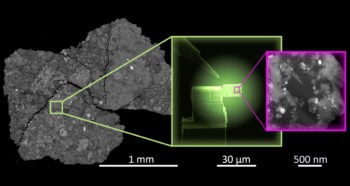
For the first time, researchers have captured an image of an electron’s orbital probability cloud within an exciton. Keshav Dani, and colleagues at Japan’s Okinawa Institute of Science and Technology Graduate University, produced the image by kicking electrons out of their orbits using tightly controlled laser pulses, and then measuring their trajectories with an ultra-precise electron microscope. Their results could lead to a new understanding of exciton properties that have long evaded physicists.
When an electron within a semiconductor absorbs a photon of sufficient energy, it will be excited to a higher energy level, leaving behind a positively-charged hole. Due to their mutual attraction, both particles will then briefly orbit each other, creating a neutral quasiparticle called an exciton. Excitons are key to the operation of semiconductor technologies, but so far, they have proven extremely difficult to study. Not only can excited electrons fall back into their respective holes within just picoseconds; the quasiparticles can also be easily broken apart.
As a result, key exciton properties, including their momenta, and the characteristics of their electron-hole orbits, have only been described theoretically. In their research, Dani’s team introduced a new setup, which allowed them to image these orbits directly. To do this, they first used a laser pulse to generate excitons within a low-temperature 2D semiconductor: an atomically-thin material where excitons can last for a relatively long time before electron-hole recombination.
Extreme ultraviolet photons
With a second pulse, they then fired extreme ultraviolet photons at the excitons. This kicked their electrons into the vacuum of an electron microscope, which uses the wave-like properties of electrons to produce images at sub-atomic resolutions. By measuring the angles and energies of these displaced electrons using the microscope, the researchers could then determine their positions within their original excitons, at the exact moment before they were kicked out.
The process is comparable to the high-energy collisions carried out at particle accelerators: from the trajectories of the particles produced by collisions, physicists can deduce the nature of particles before they are smashed apart. By making measurements over many cycles of exciton production and destruction, Dani and colleagues could gradually build up images of the wavefunctions of electrons within their exciton orbits. These mathematical relationships relate to the probability of finding electrons in a given position when observed, according to Heisenberg’s uncertainty principle.

Chiral surface excitons spotted on topological insulator
In a striking image, Dani’s team could clearly see the 3D wavefunction, or “probability cloud” of an excited electron within its orbit around a hole. The ability to visualize internal orbits in this way could give researchers unprecedented control over the properties of quasiparticles, potentially leading to advanced new quantum technologies, and exotic new states of matter. The research could also lead to a better way of studying other composite particles such as hadrons, which are made up of quarks.
The research is described in Science Advances.



